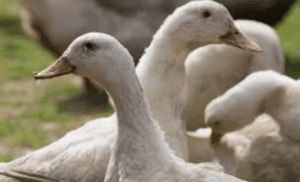This post was provided by News Now Warsaw
News Release
INDIANAPOLIS — State officials have confirmed new cases of highly pathogenic avian influenza at duck farms in LaGrange County and Elkhart County, marking the first reported outbreak in Indiana since June.
A control area and a surveillance zone have been established around the site, covering portions of LaGrange, Elkhart and Noble counties. Testing will be conducted on nearby flocks to determine whether the virus has spread beyond the initial farm.
The Indiana State Board of Animal Health said the affected LaGrange farm houses more than 2,600 ducks that have been placed under quarantine, with the Elkhart County farm seeing more than 3,500 ducks affected. The board did not disclose the exact location of the facility.
The state had regained its highly pathogenic avian influenza-free status in June, following months of monitoring after earlier outbreaks. The World Organization for Animal Health grants that designation when no new infections are detected within a 28-day period after the last affected site is cleared.
Indiana saw more than two dozen bird flu cases during the first quarter of this year, leading to the depopulation of millions of birds across multiple farms. The most recent case before this week occurred in May at a non-commercial poultry operation in Porter County.
Indiana’s poultry industry employs over 12,700 Hoosiers. The state ranks first in the nation for duck production, while also ranking third for egg production and fourth for turkey production.
How Producers Can Stay Safe
With winter approaching and migratory birds passing through the area, there is increased concern about disease transmission, as wild birds are the primary -though not the only – source of HPAI spread.
Producers are urged to maintain strong biosecurity practices, according to Purdue Extension Elkhart County. If a farm does not currently have a biosecurity plan, now is the time to implement one. These measures protect not only that farm’s animals but also neighboring farms.
Take steps to reduce contact between wild birds and poultry or dairy animals. Keep feed and feed ingredients covered to prevent wild bird access. If you visit multiple poultry or dairy operations, allow for downtime between visits when possible. Changing clothes and footwear between farms also reduces the risk of spreading the virus.
Avoid sharing equipment or supplies between farms, as they can easily carry the virus. Thoroughly clean and disinfect all tools and equipment used around sick animals. Effective disinfectants include a bleach solution – 4 oz. bleach per gallon of water, laundry soap may be added, but never ammonia, Accel-Rescue products, Pine-Sol. Remember: disinfectants only work on clean surfaces, so remove all dirt and debris before applying.
Wash hands before and after handling animals. HPAI has been known to infect humans who work closely with infected animals, so proper hygiene and the use of personal protective equipment are essential for safety.
Common symptoms in poultry:
- Decreased energy, appetite, and egg production
- Sudden death without prior signs
- Swelling of the head, comb, eyelids, wattles, or hocks
- Nasal discharge, coughing, or sneezing
- Purple discoloration of wattles, legs, or combs
- Diarrhea
- Incoordination
- Misshapen or soft-shelled eggs
Common symptoms in cattle:
- Lethargy
- Fever
- Decreased appetite
- Reduced milk production
Anyone who suspects avian influenza in their flock or herd, is urged to immediately contact the Indiana Board of Animal Health, or BOAH at 1(866) 536-7593 or a local veterinarian.
The post New reports of Bird flu announced in LaGrange and Elkhart counties appeared first on News Now Warsaw.








